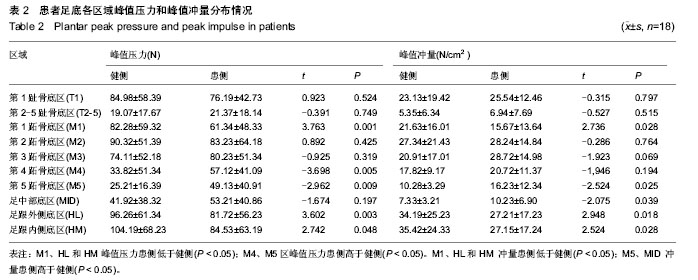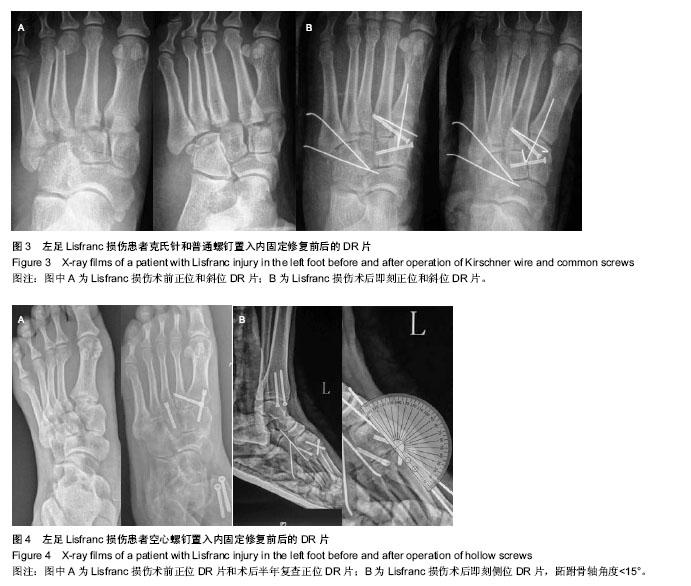| [1] van Rijn J, Dorleijn DM, Boetes B,et al. Missing the Lisfranc fracture: a case report and review of the literature. J Foot Ankle Surg. 2012;51(2):270-274.
[2] 唐康来,许建中. Lisfranc关节损伤诊断与处理原则[J].中华创伤杂志,2010,26(12):1160-1163.
[3] Myerson MS,Fisher RT, Burgess AR,et al. Fracture dislocations of the tarsometatarsal joints:end resuhs correlated with pathology and 1 realnlent. Foot Ankle. 1986; 6(5):225-242.
[4] Kitaoka H,Alexander I,Adelaar R,et al.Clinical rating systems for the ankle-hind-fot,midfot,hallux and lesser toes. Foot Ankle Clins. 1994;15(7):349-353.
[5] DeOrio M,Erickson M,Usuelli FG, et al.Lisfranc injuries in sport. Foot Ankle Clin. 2009;14(2):169-186.
[6] Castro M, Melão L, Canella C, et al. Lisfranc joint ligamentous complex: MRI with anatomic correlation in cadavers. AJR Am J Roentgenol. 2010;195(6):447-455.
[7] 王亦璁.骨与关节损伤[M].3版.北京:人民卫生出版社,2004: 1152.
[8] Miswan MF,Singh VA,Yasin NF.Outcome of surgically treated Lisfranc injury:a review of 34 cases.Ulus Travma Acil Cerrahi Derg. 2011;17(6):504-508.
[9] Mayich DJ,Mayich MS.Daniels TR. Effective detection and management of Iow-velodty Lisfranc injurles in the emergency setting:principles for a subtIe and commonly nlissed entity.Can Fam Physician. 2012;58(11):1199-1204.
[10] Macmahon PI,Dheer S,Raikm SM,et al. MRI of injuries to the first interosseous cuneometatarsal(Lisfranc)ligament. Skeletal Radiol. 2009;38(3):255-260.
[11] Gupta RT,Wadhwa RP,Iearch TJ,et al. Lisfranc injury:imaging findings for this important but often-missed diagnosis. Curr Probl Diagn Radiol. 2008;37(3):115-126.
[12] 肖松,黄剑虹,陈高峰.切开复位内固定治疗跗跖关节损伤17例报告[J].骨科,2011,48(4):184-186
[13] Watson TS, Shurnas PS, Denker J. Treatment of Lisfranc joint injury: current concepts. J Am Acad Orthop Surg. 2010;18(12): 718-728.
[14] Panchbhavi VK.Orentation of the “Lisfranc screw”. J Orthop Trauma. 2012;26(11):e221-e224.
[15] 杨兵,江庭彪,韦家宁. 手术治疗Lisfranc骨折脱位临床体会[J]. 实用骨科杂志,2013,19(1):30-32.
[16] Wright A,Gerhart AE.Lisfranc fracturesr. Adv Emerg Nurs J. 2009;31(4):269-276.
[17] Chaney DM.The Lisfranc joint.Clin Podiatr Med Surg. 2010; 27(4):547-560.
[18] Lundeen G,Sara S.Technique tip:the use of a washer and suture endobutton in revision lisfrane fixation.Foot Ankle Int.2009;30(7):713-715.
[19] Panehbhavi VK,Vallumpalli S,Yang J,et al. Screw fixation compaMl with suture-button fixation of isolated Lisfranc ligament injuries.J Bone Joint Surg(Am). 2009;91(5): 1143-1148.
[20] Sands AK,Grose A.Lisfranc injuries.Injury. 2004;35(Suppl 2):71-76.
[21] 张云峰,段洪,周立新,等.切开复位内固定治疗早期Lisfranc关节损伤[J].中华创伤杂志,2011,27(4):346-348.
[22] 杨光诗,徐林,林国栋,等. 切开复位内固定治疗Lisfranc损伤的疗效分析[J].中华创伤骨科杂志,2012,14(7):643-644.
[23] Karaindros K, Arealis G, Papanikolaou A, et al. Irreducible Lisfranc dislocation due to the interposition of the tibialis anterior tendon: case report and literature review. Foot Ankle Surg. 2010;16(3):68-71.
[24] Nunley JA,Vertullo CJ.Classification,investigation,and management of midfoot sprains:Lisfrane injuries in the athlete. Am J Sports Med. 2002;30(6):871-878.
[25] Eleftheriou KI, Rosenfeld PF, Calder JD.Lisfranc injuries: an update. Knee Surg Sports Traumatol Arthrosc. 2013;21(6): 1434-46.
[26] Mittlmeier T, Beck M. Injuries of the midfoot. Chirurg. 2011; 82(2):169-186.
[27] Henning JA,Jones CB,Sietsema DL,et al.Open reduction internaifixation versus primary arthrodesis for Lisfranc injuries: a prospective randomized study.Foot Ankie Int. 2009;30(10): 913-922.
[28] Young CR. The F-SCAN system of foot pressure analysis. Clin Podiatr Med Surg. 1993;10(3): 455-461.
[29] 姚琦,陈迎春,张亘瑷,等.空心螺钉三柱重建技术治疗Lisfranc关节损伤[J].中华创伤杂志,2011,27(10):893-895.
[30] Coetzee JC,Ly TV. Treatment of primarily ligamentous Lisfranc joint injuries:primary arthrodesis compmecl with open reduction and internal fixation.Surgical technique.J Bone Joint Surg Am. 2007;89(Suppl 2 Part 1):122-127.
[31] Joveniaux P, Ohl X, Harisboure A, et al. Distal tibia fractures: management and complications of 101 cases. Int Orthop. 2010; 34(4): 583-588.
[32] Tadros AM, Al-Hussona M. Bilateral tarsometatarsal fracture-dislocations: a missed work-related injury. Singapore Med J. 2008;49(9):234-235. |


.jpg)
.jpg)